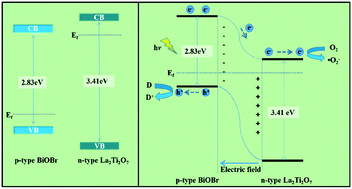当前位置:
X-MOL 学术
›
Catal. Sci. Technol.
›
论文详情
Our official English website, www.x-mol.net, welcomes your
feedback! (Note: you will need to create a separate account there.)
An atomic insight into BiOBr/La2Ti2O7 p–n heterojunctions: interfacial charge transfer pathway and photocatalysis mechanism
Catalysis Science & Technology ( IF 4.4 ) Pub Date : 2019/12/16 , DOI: 10.1039/c9cy02230a Huizhong Wu 1, 2, 3, 4, 5 , Ruimin Chen 1, 2, 3, 4, 5 , Hong Wang 5, 6, 7, 8, 9 , Wen Cui 1, 2, 3, 4, 5 , Jieyuan Li 5, 6, 7, 8, 9 , Jiadong Wang 1, 2, 3, 4, 5 , Chaowei Yuan 1, 2, 3, 4, 5 , Lin Zhuo 1, 2, 3, 4, 5 , Yuxin Zhang 5, 10, 11, 12 , Fan Dong 1, 2, 3, 4, 5
Catalysis Science & Technology ( IF 4.4 ) Pub Date : 2019/12/16 , DOI: 10.1039/c9cy02230a Huizhong Wu 1, 2, 3, 4, 5 , Ruimin Chen 1, 2, 3, 4, 5 , Hong Wang 5, 6, 7, 8, 9 , Wen Cui 1, 2, 3, 4, 5 , Jieyuan Li 5, 6, 7, 8, 9 , Jiadong Wang 1, 2, 3, 4, 5 , Chaowei Yuan 1, 2, 3, 4, 5 , Lin Zhuo 1, 2, 3, 4, 5 , Yuxin Zhang 5, 10, 11, 12 , Fan Dong 1, 2, 3, 4, 5
Affiliation

|
Novel p–n heterojunction BiOBr/La2Ti2O7 nanocomposites were synthesized through a hydrothermal method and applied to photocatalytic NO removal. The reaction course of visible light photocatalytic NO removal was dynamically monitored by in situ FT-IR, and free radicals were captured by electron spin resonance (ESR). The reaction mechanism of photocatalytic NO oxidation on BiOBr/La2Ti2O7 was revealed. Density functional theory (DFT) calculations show that when BiOBr comes into contact with La2Ti2O7 to form a p–n heterojunction, the charge could transfer from the La atom of La2Ti2O7 to the O atom of BiOBr, leading to the accumulation of negative charge in the BiOBr region. When the Fermi levels of BiOBr and La2Ti2O7 are in equilibrium, an internal electric field (IEF) from La2Ti2O7 to BiOBr is established simultaneously. Under visible light illumination, the photogenerated electrons (e−) in the conduction band (CB) of BiOBr would migrate to the CB of La2Ti2O7 with the assistance of the IEF, and the holes (h+) are gathered on the valence band (VB) of BiOBr. With this IEF, the charge carrier separation on BiOBr/La2Ti2O7 was highly promoted and thus the visible light photocatalytic NO removal performance was enhanced. This work provides a new perspective on the understanding of the construction mechanism of p–n type heterostructures and the mechanism of gas–solid phase photocatalytic reactions.
中文翻译:

BiOBr / La2Ti2O7 p–n异质结的原子洞察:界面电荷转移途径和光催化机制
通过水热法合成了新型的p-n异质结BiOBr / La 2 Ti 2 O 7纳米复合材料,并将其用于光催化脱除NO。通过原位FT-IR动态监测可见光光催化脱氮的反应过程,并通过电子自旋共振(ESR)捕获自由基。揭示了BiOBr / La 2 Ti 2 O 7上光催化NO氧化的反应机理。密度泛函理论(DFT)计算表明,当BiOBr与La 2 Ti 2 O 7接触形成ap–n异质结时,电荷可能从La的La原子转移在BiOBr的O原子上形成2 Ti 2 O 7,导致BiOBr区域中负电荷的积累。当BiOBr和La 2 Ti 2 O 7的费米能级处于平衡状态时,会同时建立从La 2 Ti 2 O 7到BiOBr的内部电场(IEF)。在可见光下的照明,光生电子(e - )在BiOBr的导带(CB)将迁移〜La的CB 2的Ti 2 ö 7与IEF的协助下,和空穴(h +)聚集在BiOBr的价带(VB)上。利用该IEF,大大促进了BiOBr / La 2 Ti 2 O 7上的载流子分离,从而提高了可见光光催化NO去除性能。这项工作为对p-n型异质结构的构造机理和气相-固相光催化反应机理的理解提供了新的视角。
更新日期:2020-02-13
中文翻译:

BiOBr / La2Ti2O7 p–n异质结的原子洞察:界面电荷转移途径和光催化机制
通过水热法合成了新型的p-n异质结BiOBr / La 2 Ti 2 O 7纳米复合材料,并将其用于光催化脱除NO。通过原位FT-IR动态监测可见光光催化脱氮的反应过程,并通过电子自旋共振(ESR)捕获自由基。揭示了BiOBr / La 2 Ti 2 O 7上光催化NO氧化的反应机理。密度泛函理论(DFT)计算表明,当BiOBr与La 2 Ti 2 O 7接触形成ap–n异质结时,电荷可能从La的La原子转移在BiOBr的O原子上形成2 Ti 2 O 7,导致BiOBr区域中负电荷的积累。当BiOBr和La 2 Ti 2 O 7的费米能级处于平衡状态时,会同时建立从La 2 Ti 2 O 7到BiOBr的内部电场(IEF)。在可见光下的照明,光生电子(e - )在BiOBr的导带(CB)将迁移〜La的CB 2的Ti 2 ö 7与IEF的协助下,和空穴(h +)聚集在BiOBr的价带(VB)上。利用该IEF,大大促进了BiOBr / La 2 Ti 2 O 7上的载流子分离,从而提高了可见光光催化NO去除性能。这项工作为对p-n型异质结构的构造机理和气相-固相光催化反应机理的理解提供了新的视角。











































 京公网安备 11010802027423号
京公网安备 11010802027423号